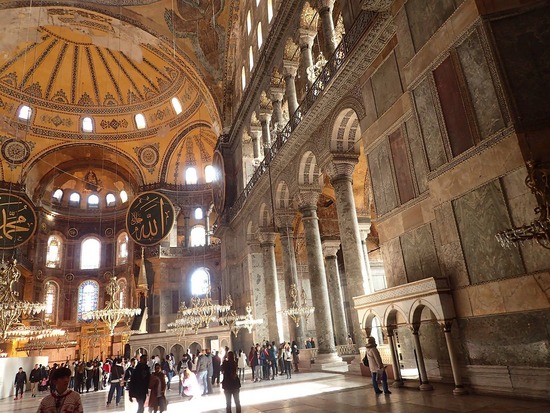| About this blog: |
Neil and I took a two week winter vacation to Turkey for a few reasons: we had been impressed by the Roman ruins at Ephesus on cruise trips but didn't have enough time to explore; we were also fascinated by Turkish ceramics and own a few pieces in our home. Recently a compelling historical documentary about Byzantine Empire impressed us with this fact: the Byzantine Empire was the missing link between the classical civilization of ancient Rome and the Islamic and Russian civilizations of today. From a broad brush perspective, the Byzantine Empire protected vulnerable Western Europe from Islamic conquest in the Middle Ages; when its own thousand-year-old institutional inflexibility lead to its eventual downfall, Byzantium unintentionally provided material treasures, ancient knowledge, and well-educated intellectuals that jump-started the Western European Renaissance.
A brief history: after the Trojan War in the 13th century B.C. the land of Turkey was settled by ancient Greeks, who came to dominate the whole of Middle East following Alexander the Great's conquest of Persia. It was incorporated into the Roman Empire in the 1st century B.C., then in 330 AD emperor Constantine the Great chose a small Greek town Byzantium to establish a new Roman capital - Nova Roma ("New Rome" - Constantinople, now Istanbul) - and remade the empire into a Christian theocracy. Owing to their ancient expertise, unifying power of Christianity, and Constantinople's impregnable natural defenses, the empire survived the barbarian invasions that devastated Western Europe, and remained the leading Christian civilization for a thousand years. After the 7th century it no longer ruled Western Europe and the city of Rome, later scholars refer to it as the Byzantine Empire, or the East Roman Empire. The Byzantines converted most Slavic peoples to Orthodox Christianity, and developed the Cyrillic alphabet for Slavic languages. After the 12th century as Italian trading states Venice and Genoa became maritime powers, the empire struggled to fight back threats from all directions - Arabs from the east, Slavs from the north, Normans and Italians from the west. Around the same time, nomadic Turks originating in the steppes north of China migrated west, converted to Islam, and settled in the Byzantine heartland - Anatolia. In 1204 Venice deceitfully redirected a crusade that toppled the Byzantine emperor and devastated Constantinople, plundering its most magnificent relics and artworks. From their base in Nicaea (Iznik) in Anatolia, in 50 years the weakened Byzantine Greeks took back Constantinople only by forming an alliance with the Turks. They were finally conquered by Ottoman Turks in 1453, a hundred years after the Turks had conquered all the lands surrounding the city and Slavic lands in Europe. The Ottomans went on to conquer extensive territories in three continents: a large part of Eastern Europe (now Greece, Serbia, Bulgaria, Albania, Romania, Hungary), the Middle East, and North Africa. Ottoman sultans became the guardians of Islamic holy sites in Mecca and Medina; they became Caliphs - successors of Prophet Mohammed and leaders of all Muslims. The Empire gradually declined after four hundred years, finally collapsing during WWI, when all the outlying lands in the Middle East and Europe were taken by European powers. Then Mustafa Kemal Ataturk lead a movement to abolish the sultans and the Caliphate, establishing a secular republic in 1923 modeled after Switzerland and France. His wholesale Westernization efforts (including adoption of the Latin alphabet instead of the Arabic alphabet, and giving equal rights to women earlier than most European countries) set Turkey on the path to become a stable democracy and to modernize under the influence of Western Europe. Turkey also became a military ally of the United States under the NATO organization.
Turkey is a popular vacation destination for Western tourists; knowing this emboldened us to strike out on our own. Exceeding our expectations, we experienced friendly, confident, accommodating, sophisticated, and stylish Turkish people on our trip. We want to share our experiences in Turkey through this blog, complete with pictures taken by Neil. A designer by trade, he has a keen eye for the most refined and unusual visions.
Our travels in Turkey brought colorful impressions of the grandeur, romance, and intellectual discovery of history's first melting pot. This is a land so strategically positioned that many ethnic groups in three millenia came and fought over it, leaving their cultures and art imprinted on the land. The customs, food, and physical appearances of these peoples have been preserved to this day. Turkey is a virtual encyclopedia of the old world's myriad cultures, so much so the whole country has been called "the world's largest museum". Of particular interest to Western visitors, Turkey was the birthplace of organized Christian Church, where apostles Peter and Paul laid foundations of the practice of Christianity. Apostle Peter founded the first Christian church in Antioch - now Antakya in Turkey; the doctrine of Trinity was accepted as the foundation of both Catholic and Orthodox faiths at the first council of Nicaea - now Iznik in Turkey.
Truly remarkable is Istanbul, the city straddling two continents - it is a singular phenomenon of a trading and cultural hub whose resurgent influence far surpasses national borders to this day. No longer the center of a world-dominating empire as it had been for two millenia, nor the capital of two major world religions, this extraordinarily beautiful city fervently embraces its natural role as the center of luxury and refinement radiating outward to different continents and cultures - Islamic, Western European, Russian/Slavic, and Central Asian.
|

